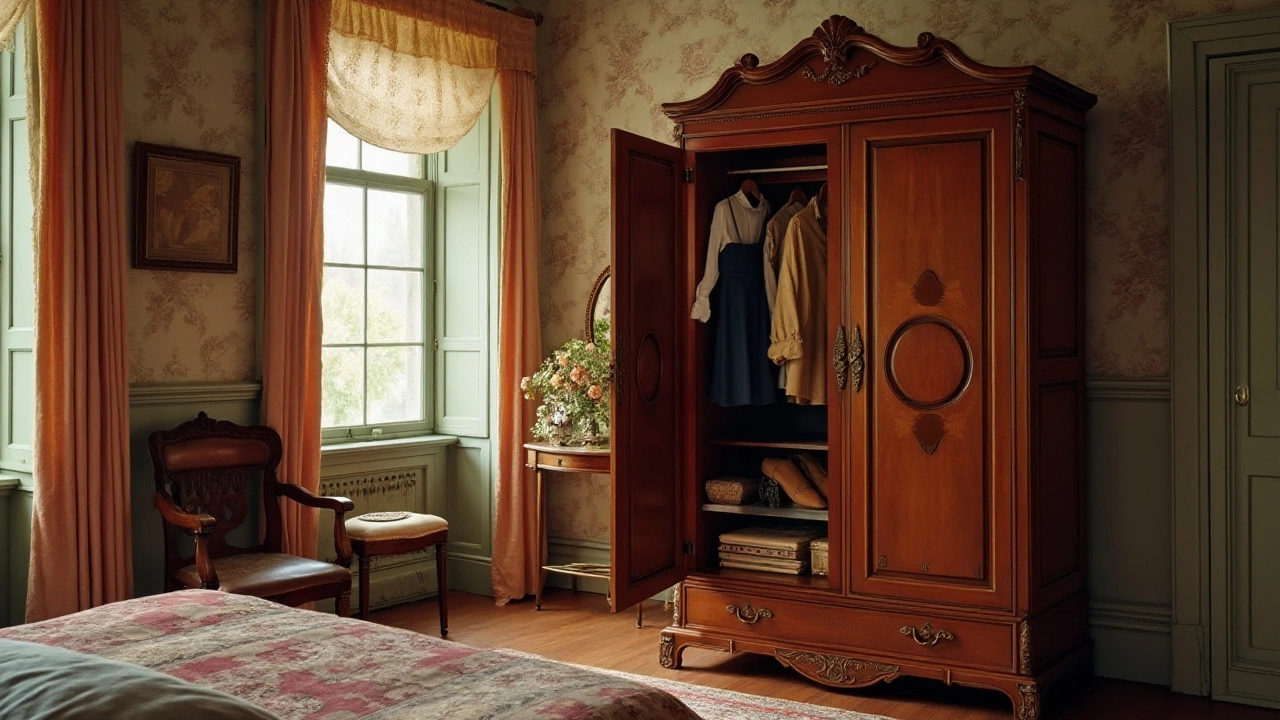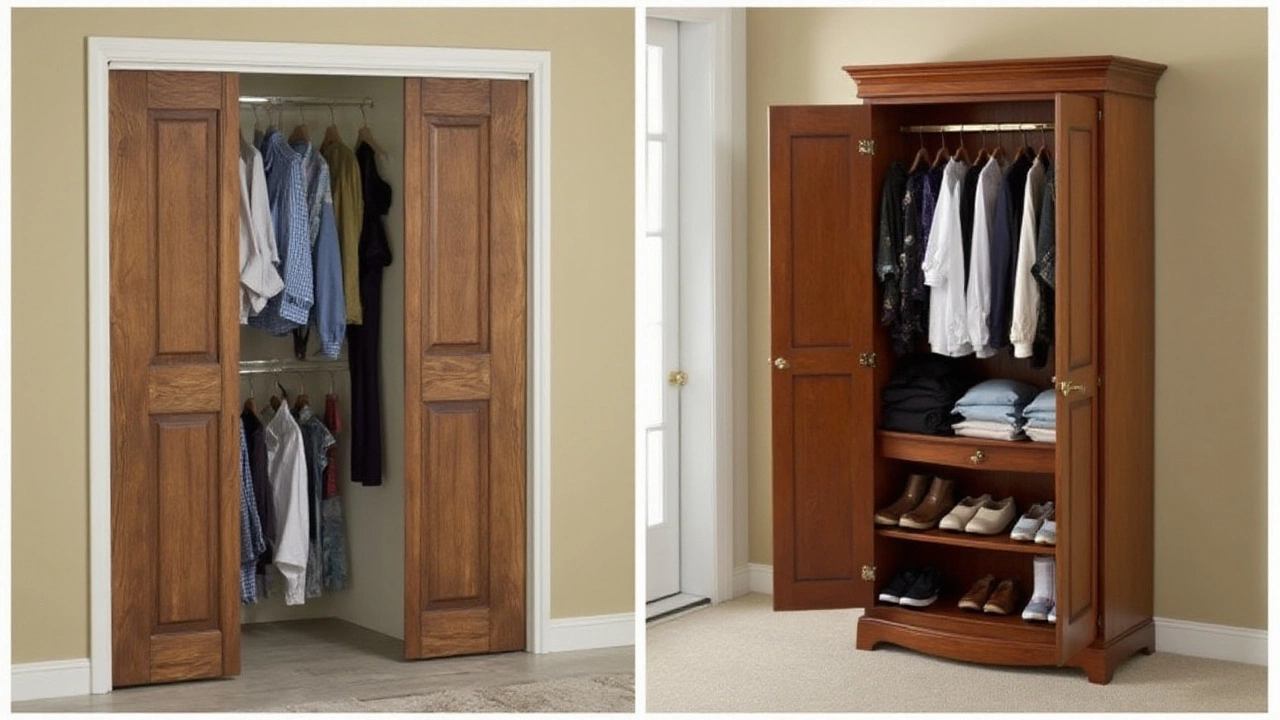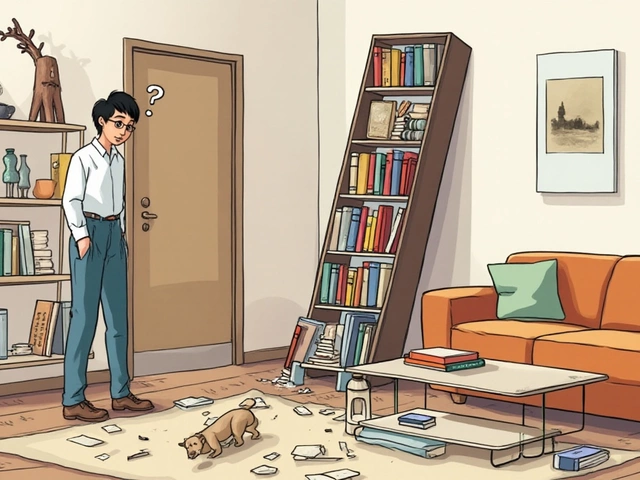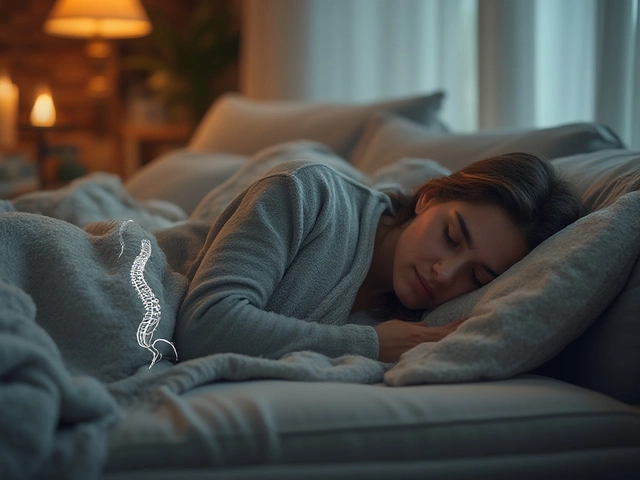
Language is a fascinating window into culture, revealing not just what we say, but how we live. In the United States, the terms 'closet' and 'wardrobe' spark curiosity, particularly among those interested in how language evolves. Both words conjure images of spaces where we stash away our clothes, yet the choice between them isn't merely a matter of semantics.
Diving deeper, we see these terms reflect more than regional dialects—they uncover histories of innovations in home design, shifts in lifestyles, and quirks in cultural identity. Whether pondering the proper place for a pair of shoes or understanding an American's vocabulary, grasping the nuances between closets and wardrobes offers both practical insights and cultural knowledge.
- The Origins of Closet and Wardrobe
- Regional Preferences in the United States
- Design Differences Between Closets and Wardrobes
- Cultural Influences on Terminology
- Tips for Organizing Your Space
The Origins of Closet and Wardrobe
The words closet and wardrobe have rich histories that span continents and centuries, each tracing its own path through language and architecture. The term 'closet' is rooted in the Latin word 'clausum,' meaning closed space. It entered the English language through the French word 'closet,' which referred to a small room for privacy. In medieval times, a closet served as a private retreat within a larger home, a place for meditation or study where the lord of the manor could be undisturbed by the hustle of daily life. Over time, as homes evolved and personal spaces became more designated, the closet transformed from a room for solitude into a dedicated space for storing personal belongings, particularly clothes.
On the other hand, the wardrobe came from the Old French term 'warderobe,' which roughly meant 'guarding clothes.' Its roots hint at its function during the Middle Ages—a large piece of movable furniture where garments were kept safe from dust and pests. Wardrobes were often grand and lavish, reflecting the wealth and status of their owners. As societies progressed and fixed architecture took precedence over portable pieces, the term 'wardrobe' started to denote both a freestanding piece of furniture and, in some cultures, an entire room for storing clothes. This dual usage persists in several countries today, highlighting the word's adaptability across different regions.
These historical tales shed light on what shaped the use of these words in modern times. The American preference for the term 'closet' likely stems from its early architectural adoption. As American homes grew in size in the 20th century, the incorporation of built-in closets became a norm, aligning with the American ethos of practicality and domestic efficiency. Unlike their European counterparts, Americans typically favor built-in solutions, a sentiment perhaps echoed by the openness of the American frontier and the need for innovative uses of interior space. In contrast, 'wardrobe' retained its connotation of elegance and class, often becoming associated with standalone units used in elegant displays or with vintage charm.
Interestingly, a study from Home and Design Magazine indicates that the average American home has more than twice the number of closets compared to European homes, pointing to a cultural inclination toward integrated storage solutions. This aligns with a broader social trend in America where functionality takes precedence. As living spaces further evolved in the 21st century, closets came to embody more than mere utility—they became expressions of individual style, with custom designs that cater to specialized needs and tastes.
"The evolution of domestic storage speaks volumes about cultural priorities," notes renowned historian Dr. Eleanor French. "While the British held on to their wardrobes, indicative of heritage and sartorial pride, the Americans leaned towards closets, embracing practicality and the notion of space customization."The historical journey of these words, then, is not just an etymological study but also a narrative of how societies shape and reshape their environments, laced with cultural priorities and practical necessities. The simple choice between a closet or wardrobe goes beyond mere semantics, revealing deeper societal trends and evolutions in domestic life.
Regional Preferences in the United States
When it comes to the debate between whether to say closet or wardrobe, it largely boils down to where you are in the United States. Each region in this vast country has its own unique characteristics and quirks, and language is certainly no exception. In the northeastern states, with their colonial heritage and older architecture, the term 'wardrobe' may still ring familiar, perhaps harking back to times when freestanding furniture was more common than built-in storage. As you move towards the Midwest, where homes often have more space to spare, 'closet' becomes the definitive term, reflecting the prevalence of built-in storage solutions in modern American homes.
Down in the southern states, the influence of different European settlers can be seen in the language. Here, you might find a blend of terms, with both 'wardrobe' and 'closet' being used interchangeably, largely depending on the age and style of the home and its furnishings. It's interesting to note that many historic homes in the South, designed before the innovation of built-ins, often feature elaborate wardrobes instead.
On the West Coast, however, it's almost universally 'closet.' This is partly due to the region's modern building trends and a lifestyle that's always on the cutting edge. Many homes built in California and Washington during the 20th century were equipped with large closets, and this development shifted people's vocabulary toward the term 'closet' as a norm. West Coast living also emphasizes minimalist design, so the preference for the efficiency of a closet over a bulky wardrobe remains strong today.
The regional preference is not merely a reflection of architectural styles and home layouts but also speaks volumes about cultural influences. The shift towards using 'closet' more frequently across the nation can also be attributed to the dynamism of the media and entertainment industries, which often standardize language trends. A quote from a well-regarded American architect once noted,
"The closet space is an integral part of the modern American home, a portrayal of our evolving needs for organization and privacy."Such quotes offer a window into how closely tied language and lifestyle can be.
To add a bit of hard data, let's consider the terminology used in popular home improvement TV shows and literature. In a survey of scripts from the past decade's most popular real estate shows, 'closet' appeared in 80% of the episodes, while 'wardrobe' was mentioned only 20% of the time. This might show a strong tendency towards standardizing the use of 'closet' nationwide as younger generations pick up terms from media exposure.

Design Differences Between Closets and Wardrobes
When stepping into the realm of home design, the selection between a closet and a wardrobe often hinges on both practical and aesthetic desires. While the two serve the common purpose of clothing storage, their form and function are distinct. A closet is typically a built-in space, part of the architectural bones of a home, not unlike an alcove with its secretive convenience. It provides a seamless look, blending into bedroom walls without a fuss. The traditional American closet often boasts bifold or sliding doors, designed to save space in compact rooms. In contrast, a wardrobe is a standalone piece of furniture, an exquisite artifact in history, tracing back to times when such furnishings were indicative of wealth and taste.
The design of a wardrobe is dictated by individual taste—it can be a minimalist modern piece or an ornate vintage style with mirrors and carvings. Wardrobes also come equipped with drawers and compartments, offering more versatility in storage solutions for things like accessories, shoes, or even luggage. More modern designs, inspired by European sensibilities, focus on maximizing vertical space and may feature smarter interior fittings like adjustable shelves and LED lighting. Closets, in comparison, are often nothing more than rods and shelves, waiting to be customized.
"The evolution of closet space reflects broader trends in the architecture of living spaces and consumer habits," notes interior designer Jane Bullock, emphasizing how personal style and practicality play a role in this choice.
A significant aspect of closets is their adaptability through ingenious use of space. Frequently, they are transformed into walk-in wardrobes, if the home’s layout and budget allow for such luxury, turning a simple closet into a lavish showcase for fashion. Conversely, wardrobes, being movable and versatile, offer a level of freedom that permanent fixtures cannot. This mobility is invaluable to renters who cannot make structural changes, or homeowners who cherish flexibility in their layout.
The consideration between using a closet or a wardrobe may also impact heating and air circulation within a room since wardrobes, being large furniture, can influence how space feels and flows. On the other hand, closets tucked within walls often feel like an extension of one’s personal space, offering privacy and continuity. Understanding the design differences between these storage solutions can greatly influence the functionality and style of your home.
Cultural Influences on Terminology
The choice between 'closet' and 'wardrobe' isn't as straightforward as it might appear. These terms are deeply rooted in cultural narratives that stretch back centuries, mapping out the evolution of language alongside societal advancements. In America, the prevalence of 'closet' reflects a certain practicality and efficiency, qualities that have historically defined the American ethos. Encompassing everything from expansive walk-ins to modest pantry spaces, closets have become synonymous with an element of orderliness cherished in American homes. This linguistic preference underscores how terminology often dovetails with the values of a society.
The British influence on American English is unmistakable, yet regional differences have drawn unique lines in language. Traditionally, a 'wardrobe' in Britain referred to an independent piece of furniture that allowed for the luxury of choice, with its grand, often ornate presence suggesting opulence. As America matured and urbanization surged, the concept of reducing furniture usage for the sake of space marked a shift towards built-in closets. This not only reflected changing architectural trends but also signaled a divergence in vernacular. In contemporary American culture, 'wardrobe' occasionally resurfaces, popularized by high-end design magazines and the rise of minimalism.
As journalist Nora Ephron once remarked, "A closet is a place of abundance, while a wardrobe is a well-curated gallery of one's personal style." This differentiation captures the cultural dynamics at play, where a closet serves as an all-encompassing storage unit, and a wardrobe signifies the selective nature of modern style curation. The American embrace of closets aligns with the national tendency to maximize utility and space efficiency.The socioeconomic dimensions of these terms also present intriguing insights. Homeownership patterns and housing design trends contribute significantly to the preference for closets in American homes. The post-war housing boom saw an era of architectural designs that integrated closets as essential features, unlike Victorian homes where standalone wardrobes were the norm. This transition marks a broader cultural shift towards streamlined living. The rise of suburban neighborhoods necessitated functional solutions, where 'walk-in closets' became symbols of the new middle-class aspirations—a reflection of the American dream.
In urban centers where living spaces shrink, the appeal of 'closets' adapts, yet wardrobes gain a foothold in lofts and vintage apartments, nodding to their European roots. This juxtaposition of terms in different contexts speaks volumes about America's melting-pot identity, accommodating European legacies while forging new paradigms. The context in which these terms are used reflects not merely architectural differences but an evolution towards acknowledging personal taste and lifestyle choices. From retail's 'capsule wardrobes' advocating simplicity to suburban closets capable of housing everything from sports equipment to seasonal clothing, the interplay between closet and wardrobe remains a captivating narrative of cultural evolution.

Tips for Organizing Your Space
Organizing a closet or wardrobe goes beyond merely finding space; it's about creating a system that caters to your lifestyle and habits. The key to a well-organized space is to make it functional and visually appealing. Start by emptying everything out. It might seem like a daunting task, but it's crucial for gaining a full understanding of what you own, what you actually wear, and what you need to keep. Spread your items on a bed or floor, organizing them into categories like pants, shirts, shoes, and so forth. This way, you'll identify repeats or forgotten treasures hiding in the depths of your closet or wardrobe.
Once everything is out in the open, decide what to keep and what to let go of. Clutter experts often suggest using the 'one-year rule': if you haven't worn it in a year, consider parting ways with it. Keep items that fit well and make you feel good wearing them. As environmental consciousness rises, consider donating unneeded yet useful items to thrift shops or shelters instead of sending them to a landfill. In the words of Marie Kondo, "The goal of tidying is to make room for meaningful objects and genuine joy."
"Storage experts often say, 'Make your storage fit your life, not the other way around.'"――Shira Gill, organization expertWith your essentials picked, think about how you’ll store them efficiently. Use every inch of your closet or wardrobe. Install extra rods for hanging clothes at different lengths, or use adjustable shelves to accommodate changes in your wardrobe. Avoid leaving piles on the floor, as they tend to become chaotic over time. Utilize boxes or bins for accessories and smaller items—you can label them so nothing gets lost. Hooks on the inside of doors can be perfect for accessories like belts or scarves.
If you have a mix of seasonal items or live in a place with varying climates, consider storing off-season clothes in another section or using breathable storage bags to keep them fresh. Arrange your clothing by type or color, whichever method feels intuitive to you—color coordination can even help brighten your mood during drearier mornings.
Don't overlook lighting. It's often a neglected component, but proper lighting can dramatically alter the usability of your space. Consider adding LED strip lights, battery-operated tap lights, or built-in motion sensors to brighten things up. A well-lit space helps not only in locating clothes but also in maintaining the order you worked hard to create.
Ultimately, maintaining order in a closet or wardrobe should align with how you use it daily. Daily habits solidify your storage organization for the long term. Reserve a few minutes each week to put clothes back where they belong, reevaluating arrangements as your needs evolve. With these thoughtful strategies, your clothing storage can thrive as a sanctuary of style and functionality.



